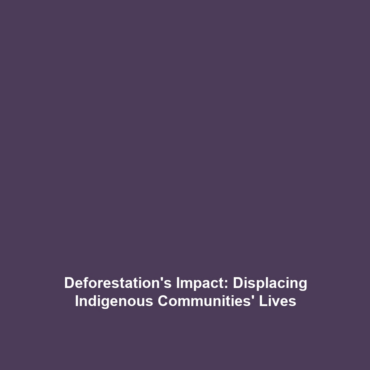How Deforestation Displaces Indigenous Communities and Threatens Their Ways of Life
Deforestation is an escalating crisis that significantly impacts biodiversity and the cultural integrity of indigenous communities. As forests are cleared for agricultural expansion, logging, and urban development, indigenous people’s homes and traditional practices are increasingly threatened. This article explores the profound effects of deforestation on indigenous communities, emphasizing its relevance within the larger context of deforestation and biodiversity loss.
Key Concepts
Understanding the relationship between deforestation and the displacement of indigenous communities is crucial in addressing biodiversity loss. Major concepts include:
- Indigenous Rights: Indigenous communities hold cultural and historical ties to the land, which are often disregarded in national and international policies.
- Biodiversity Loss: Deforestation leads to habitat destruction, adversely affecting both flora and fauna, diminishing the ecological balance.
- Land Grabbing: Large corporations often acquire lands inhabited by indigenous populations without consent, leading to displacement and cultural erosion.
Applications and Real-World Uses
How deforestation displaces indigenous communities can be examined through various real-world applications:
- Environmental Advocacy: Organizations can leverage data on deforestation impacts to advocate for indigenous rights and conservation.
- Policy Development: Governments and NGOs can utilize findings to shape policies that protect both biodiversity and the rights of indigenous peoples.
- Community-Led Initiatives: Supporting indigenous-led conservation projects can help not only preserve ecosystems but also uphold traditional knowledge and practices.
Current Challenges
The challenges related to studying how deforestation displaces indigenous communities include:
- Data Scarcity: Lack of sufficient data on indigenous populations and their ecological knowledge can hinder effective policy-making.
- Political Resistance: There may be significant opposition from industry stakeholders against implementing protective measures for indigenous land.
- Cultural Misunderstanding: There is often a gap in understanding indigenous cultures which can lead to ineffective solutions.
Future Research and Innovations
Future research is vital for addressing the impacts of deforestation on indigenous communities. Innovations may include:
- Remote Sensing Technology: Enhanced satellite imagery and remote sensing could help monitor deforestation in real-time, aiding conservation efforts.
- Culturally Inclusive Conservation Strategies: Developing conservation initiatives that incorporate indigenous knowledge can foster sustainable land management.
- Community Engagement Platforms: Online platforms that empower indigenous voices and connect them with conservationists can drive collaborative solutions.
Conclusion
Deforestation poses a significant threat to indigenous communities, displacing them from their ancestral lands and undermining their cultural identities. The interconnectedness of deforestation and biodiversity loss necessitates immediate action. It is essential for local and global communities to advocate for policies that safeguard indigenous rights and ensure ecological preservation. For further reading on the impact of deforestation, consider exploring this related article on biodiversity loss or our resources on indigenous rights.

Leave a Reply